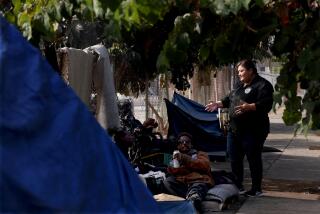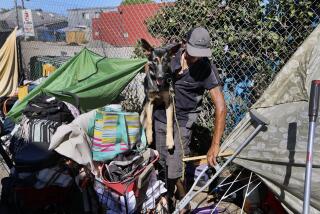Migration of Homeless to Balboa Park Causes Concern and Frustration
- Share via
Frank is tired of “the homeless rap.”
He’s tired of shivering in the morning, of scrambling for food, of cocking an eye over his shoulder at police who he says confiscate sleeping bags and clothing--”even if it’s all an old boy has.”
Frank, who asked that his last name not be published, came to San Diego three weeks ago from Corpus Christi, Tex. Homeless for some time there too, he came to “America’s Finest City” “ ‘cause it’s warm.”
He has yet to find work, either as a carpenter, his usual calling, or as anything else. He spends about six hours a day looking for jobs. Thursday afternoon, he sat on the grass at Balboa Park, looking through want ads, circling possibilities with a smeary Bic pen.
He said he’s tired of “the edge,” of seeing eyes look askance, of feeling shamed and rootless.
Congregate in Park
Frank, 20, is among the legions of homeless now congregating just west of the Cabrillo Bridge in Balboa Park. He and his cohorts have drawn the ire of the San Diego Police Department and at times angered elders of St. Paul’s Episcopal Church, which allows the homeless to camp on its grounds at 6th Avenue and Nutmeg Street at night.
Frank sees no end in sight. His ocean-blue eyes take on a hang-dog expression when he’s asked what the three weeks have been like. He said his only money comes from what he draws from donating plasma (white blood cells) twice weekly. Each time he goes, he gets paid $12.
“There’s nothin’ there,” he said of Texas, where he left behind a stepmother, his only surviving family. She, too, is homeless. “No jobs at all, really. This is a rich town, but from what I can tell, ain’t nothin’ here either.”
He sniffed, looking at the children chasing through the park.
“This place ain’t much different from Texas,” he said. “You people have sold everybody a bill of goods.”
Crackdown Alleged
A group of about two-dozen homeless people interviewed late last week in the park said police confiscated sleeping bags, clothing and other personal articles during a crackdown earlier in the week.
Said police spokesman Bill Robinson: “I was not aware of the confiscation. The increase (of homeless people) includes but isn’t limited to the park. The park is popular. You can hide in the shrubs and under bushes without being observed. But officers patrol the park and are aware of the situation.”
“The situation,” Richard Beaty said, is one of collective poverty, frustration and sadness. Beaty, 31, came to San Diego from Santa Barbara in December and hasn’t had a home since. He said his things were taken earlier this week by police, along with those of several elderly friends.
“Luckily, I had a friend who loaned me a blanket and a new bag,” Beaty said. “But a lot of these old-timers, hey, they was on Social Security.”
Beaty said that many homeless people had taken to leaving their bags in the park during the day, before venturing out for jobs, food, whatever. One or two would stay behind as a kind of sentry, but “ain’t no way you can guard three car-loads of cops,” Beaty said.
Keith Bauduin, 34, was a missionary from Fort Hood, Tex., before entering the ranks of the nation’s homeless. He said he and his wife, both Pentecostal missionaries, got a divorce and that he lost everything. Bauduin said he is now penniless and homeless but hopes for a settlement that may reward him $25,000. He’s been in Balboa Park for months, as have the other seven people who camped out with him under a eucalyptus tree one day late last week around 4 o’clock.
Bauduin and his friends sat on the grass, smoking cigarettes, complaining about their plight, laughing gently at a joke now and then. Most wore long hair and tattoos. Most of the men were shirtless. One woman lay on a sleeping bag, tugging gently at a baby’s curls. A friend, playfully invoking part of a title from an old Bob Dylan song, called her “sad-eyed lady of the low-lifes.”
Unkind Words for Police
Everyone had an unkind word for “the cops.”
Bauduin said he had been beaten by two officers several weeks ago. He complained at police headquarters. He said a “higher-up” had given him his card and told him to present it to officers who tried to harass him.
He said that police and passers-by hurl verbal abuse.
“They call us garbage, dirty people or slime,” said one of Bauduin’s friends.
Newly elected City Councilman Bob Filner represents the 8th District, which includes Hillcrest, North Park, Golden Hill, downtown and the parts of South Bay that encompass San Diego. Allen Jones, his administrative aide, said the homeless are infiltrating all of those areas and that resident complaints have intensified.
“The incidence of various types of crime is increasing,” Jones said. “You have burglaries and breaking into cars. All of these things are concerns.”
Jones said that Filner’s efforts to help are being concentrated in the areas of housing for the homeless, of which there is little, and employing at least 1,000 of the estimated 6,000 now roaming city streets.
Jones said that downtown redevelopment--particularly construction of the Horton Plaza shopping complex--had driven the homeless increasingly northward, into Hillcrest, Golden Hill and Balboa Park. Residents along 6th Avenue have voiced vociferous complaints in recent weeks, Jones said.
The rear of St. Paul’s Episcopal Church borders 6th Avenue. Dean James Carroll said as many as 45 to 65 homeless people a night sleep on the grounds and have done so for more than two years.
“We permit it, we don’t encourage it, we just don’t call the police,” Carroll said. “The people are generally responsible, but from time to time we have riffraff, bums, people irresponsible to property. The majority of people are grateful for a safe place to sleep and try to control the hooliganism of ungrateful brothers.”
High Housing Costs
Carroll said the homeless are greater in number because of the high cost of housing in San Diego. Frank Landerville, project director of the Regional Task Force on the Homeless, echoed Carroll’s concern.
“Hey, the park is the place I would be if I were homeless,” Landerville said. “It’s a natural campground and much better than a city street. We’ve had a steadily increasing population in the last 2 1/2 years. Not just the park, but surrounding areas are affected as well. Throughout the county, we have only 965 beds for the homeless to sleep in, in homeless shelters of one sort or another. I’m talking everything from small facilities, with six to eight beds, to the Joan Kroc St. Vincent de Paul Center, which has about 250.”
Food is also a problem. You can sleep on the ground, said Frank from Texas, but “you can’t eat the ground.” He said the Salvation Army brings a truck by every night around 8. Bauduin said a woman called “the Kentucky Lady” brings by food, as does “an old man in a truck.”
The toughest thing, Frank said, is trying not to lose hope.
“ That’s the battle,” he said. “Giving the plasma, hey, I know it’s not good for me. It wears you down. But you know, I kind of need the money.”
More to Read
Sign up for Essential California
The most important California stories and recommendations in your inbox every morning.
You may occasionally receive promotional content from the Los Angeles Times.










